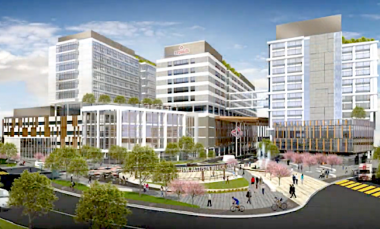
Engineered wood to be put to use in two B.C. megaprojects, Horgan says
By Hina Alam, The Canadian Press
Construction Materials
A rendering of the new St. Paul’s Hospital, one of the projects Horgan says will utilize wood. PHOTO: Providence Health Vancouver
VANCOUER, B.C.—British Columbia is moving to help revive the provincial forest industry by requiring the use of engineered wood on the new St. Paul’s Hospital and the upgrade to the Royal B.C. Museum.
Premier John Horgan told the Council of Forest Industries convention in Vancouver April 5 that he has also directed the use of engineered wood, where possible, for the $20 billion in public infrastructure being built, including schools and housing.
“It’s the province showing the way on transforming high-value products,” he said, adding that this initiative will focus specifically on ways to increase value-added production from a reduced wood fibre supply.
The industry is facing a number of challenges on different fronts such as reduced timber supply, record wildfire seasons, as well as lower prices for Western spruce, fir and pine timber, Horgan said.
“Fibre costs are going up. Lumber prices are going down. Timber supply is declining and they are all happening at the same time,” he said. “The challenges are not new but they are stark and they are significant.”
The plan, which will focus on increasing value-added production from a reduced wood supply, is the beginning of change that the forest industry needs, the premier said.
Related: Wood construction renaissance may not be quite all its built up to be, report says
The province announced earlier this year that it was changing the building code to allow for construction of wood buildings up to 12 storeys using fire-resistant engineered wood.
The government announced the Royal B.C. Museum modernization in Victoria in its throne speech and a business plan for the new $1.9-billion St. Paul’s Hospital in Vancouver was launched in February.
The province is also looking to creating opportunities for trade with China, Japan, Korea and other markets, Horgan said.
“People are building with mass wood products because it makes sense because it is cost effective and it is an enormous opportunity,” he said.
“I will do my level best to assist you by giving you the opportunity you need, by giving you the incentives you need to make the transition from high-volume to high-value,” Horgan said.
Susan Yurkovich, president of the BC Council of Forest Industries, said the industry was “highly supportive” of the provincial initiative to use wood for the two new projects.
“We are a wood-producing province. We should have wood in our public structures,” she said.
The best way to help the forest industry is to grow demand, she said, adding that a strong domestic market could mitigate trade risks.
“When you grow demand for wood (domestically) obviously there is going to be a price advantage,” Yurkovich said, noting there is are no shipping fees or duties.




